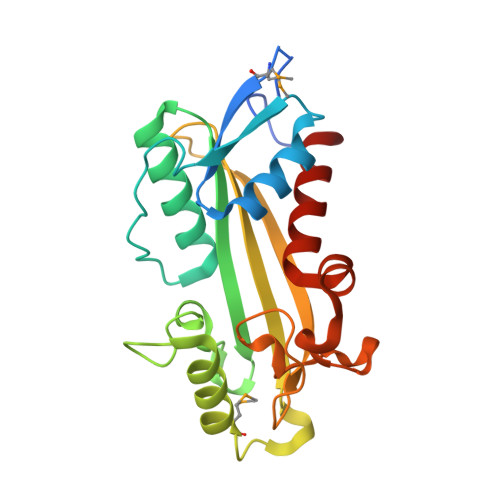Molecular basis of the antimutagenic activity of the house-cleaning inosine triphosphate pyrophosphatase RdgB from Escherichia coli.
Savchenko, A., Proudfoot, M., Skarina, T., Singer, A., Litvinova, O., Sanishvili, R., Brown, G., Chirgadze, N., Yakunin, A.F.(2007) J Mol Biol 374: 1091-1103
- PubMed: 17976651
- DOI: https://doi.org/10.1016/j.jmb.2007.10.012
- Primary Citation of Related Structures:
1K7K, 2PYU, 2Q16 - PubMed Abstract:
Inosine triphosphate pyrophosphatases, which are ubiquitous house-cleaning enzymes, hydrolyze noncanonical nucleoside triphosphates (inosine triphosphate (ITP) and xanthosine triphosphate (XTP)) and prevent the incorporation of hypoxanthine or xanthine into nascent DNA or RNA. Here we present the 1.5-A-resolution crystal structure of the inosine triphosphate pyrophosphatase RdgB from Escherichia coli in a free state and in complex with a substrate (ITP+Ca(2+)) or a product (inosine monophosphate (IMP)). ITP binding to RdgB induced a large displacement of the alpha1 helix, closing the enzyme active site. This positions the conserved Lys13 close to the bridging oxygen between the alpha- and beta-phosphates of the substrate, weakening the P(alpha)-O bond. On the other side of the substrate, the conserved Asp69 is proposed to act as a base coordinating the catalytic water molecule. Our data provide insight into the molecular mechanisms of the substrate selectivity and catalysis of RdgB and other ITPases.
Organizational Affiliation:
Banting and Best Department of Medical Research and Ontario Center for Structural Proteomics, University of Toronto, 112 College Street, Toronto, Ontario, Canada M5G 1L6.















